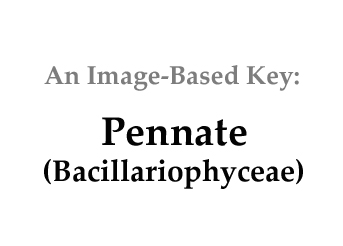
Pennate diatoms are elongate in both “valve view” and “girdle
view”. Bilateral symmetry in both
views is generally considered to be ancestral (e.g. Navicula),
while varying degrees of distortion in one or more axes that leads to
asymmetry is thought to be derived, conveying an advantage.
Presence of a “raphe” (slit in the “frustule” that in many genera follows the long axis of the valve) on both “valves” (biraphes) seems to be related to “gliding motility” if the diatom is adjacent a surface along which it can propel itself. This may be an ancestral trait found only in the benthic pennate diatoms. In addition many benthic forms are heavily silicified (e.g. Pinnularia and Caloneis) to decrease their buoyancy (increase their specific gravity) so that, like a "paper weight", they use gravity to reduce likelihood of being swept away.
Derived forms may have a raphe only on
one valve (monoraphes) with what’s called a “pseudoraphe” on the other valve – perhaps a morphological
“trace” of a former raphe. Still other genera lack raphes altogether (araphes).
In the absence of solid surfaces to push against, gliding motility cannot occur, and euplanktonic genera are araphes with lightly-silicified frustules in order to minimize cell density and reduce sinking. Movement depends entirely on water currents.
Of course genera with raphes are often collected in the planktonic zone, being easily swept off surfaces by water currents.
Some benthic pennate genera secrete mucilaginous stalks
More on pennate frustule structure

